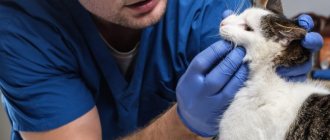(Be the first to vote!)
5589564
06/29/2021 owner reviews 1,
Red spots on cat ears quite rightly alarm pet owners, because often such manifestations indicate a serious illness. Especially when the cat starts shaking its head and scratching its ears, scratching its skin until it bleeds.
- How do ear diseases manifest themselves?
- Ear mite
- Eczema
- Hematoma
- Another reason
Allergy
Red spots on the ears, and sometimes completely red (sometimes even hot) ears indicate that the cat is suffering from an allergic reaction for some reason. This could be the environment, new food, medication, or flea saliva. To understand the cause of redness, you need to consult a specialist. Fortunately, allergies in animals are treated just as easily as in people, so after visiting the veterinarian, the cat will definitely feel better, and the redness from the ears will go away.
© shutterstock
Another reason
Other diseases that cause redness in the ear include:
- Dermatitis . The symptoms and causes are similar to eczema, but do not have the nature of an allergic reaction. There is brown dirt in your cat's ears that can be easily removed with a cotton swab. The skin is slightly inflamed.
- Otitis . This disease, which is an inflammatory process, can hardly be diagnosed at home, since the cat, on the contrary, will try to shake its head as little as possible. If you pay attention, you can hear the liquid squelching in your cat's ear. Otitis media develops against the background of a weakened immune system.
- Ringworm . It is caused by microscopic molds - trichophyte or microsporum. In addition to redness, you will notice that your pet is going bald by leaps and bounds. Peeling, possibly purulent wounds, appear on bald spots. If you notice even a small bald spot on your cat, it is better not to risk it and immediately consult a veterinarian. You can get rid of ringworm easily if you start treatment on time.
To prevent redness and other negative symptoms from appearing, take adequate time to care for your pet's ears. Inspect and carefully clean your pet's external auditory canals, and do not allow water to come into contact with his ears and nose.
Ear hematoma
The cat's ear may turn red as a result of the appearance of a so-called auditory hematoma. These problems are very painful for cats and therefore require immediate specialist intervention. Such bruises may appear for the following reasons :
- Ear injury, possibly while playing or due to a bad landing. Vessel rupture can also occur when an animal scratches or shakes its head very hard;
- Infections, allergies, ear mites - everything that provokes violent damage to the organ.
Symptoms and treatments
Among the symptoms accompanying ear redness in cats are:
- increased body temperature;
- presence of bruises on the ear and fur;
- discharge of purulent fluid from the cavity;
- irritated general condition of the animal;
- loss of appetite;
- head tremor;
- weight loss
Cats can develop various pathologies; an accurate diagnosis can only be determined by a qualified specialist based on the tests obtained. If mites are found, antiparasitic drugs are used. Otitis requires treatment with antibiotics. You can relieve inflammation and lower the temperature with the help of antipyretic medications. In the case of cancer, special treatment is necessary.
A caring owner is obliged to monitor the appearance of his pet and the behavior of the animal. If you notice any abnormalities that are not typical for your four-legged friend, you should contact your veterinarian to clarify the health status of your pet.
Otitis
Otitis is an inflammation of the ear in a cat. The disease spreads to all parts of the ear, including the inner ear. Possible causes range from allergies to ear mites and fungal infections. If the cat's ear is red inside and has an unpleasant odor, scratches are visible on the outside, and the cat itself is not behaving as usual, then most likely he has otitis media. The veterinarian will prescribe the necessary medications, and after treatment, the owner will need to keep his pet’s ears clean and regularly wipe them to remove excess earwax. This procedure is also useful for healthy cats, as it is a good prevention of inflammation.
© shutterstock
Ear diseases
Consequences of otitis media
If the inflammatory process is left unattended, external otitis develops. If recovery does not occur, the inflammation spreads to the middle ear. Medial otitis media develops.
The animal shakes its head and tilts it towards the affected shell. There is a shooting in the ear, the cat screams in pain. As a result, the pet loses hearing or the pathological process spreads to the inner ear. Due to the proximity of the brain, a life-threatening condition occurs.
Methods for diagnosing and treating the inflammatory process of the inner surface of the auricle caused by different reasons are not the same. Therefore, a special section is provided to describe each disease.
Ear injuries
Cats get wounds and scratches in fights for dominance or when they push through thorny bushes. Most often, the ear heals without any treatment. However, when dirt gets into the wound, or the cat has a weak immune system, inflammation develops.
Be sure to read:
The cat's hind legs are failing: causes, signs, what to do, best treatment methods, prognosis
Therefore, after each cat spree, you should examine the ear and treat it with an antiseptic wound-healing spray. If you try to tear the ear, wear a cervical collar. You should not apply bandages: the animal will rip them off anyway. And while the lesion is under the bandage, anaerobic conditions arise that are favorable for putrefactive microflora.
Hygienic causes of ear inflammation
Regular ear cleaning prevents otitis
Man has developed cat breeds with specific characteristics. In some pets, the anatomical structure of the shell is conducive to the accumulation of ear wax, inflammation and the spread of inflammation to the inner surface of the shell and inside the ear canal.
As a rule, in such cases they contact a veterinary specialist who conducts diagnostic tests and prescribes treatment with the following external agents:
- Bars forte: contains the antibiotic Enrofloxacin, the antifungal agent Miconazole;
- Otibiovin or Otibiovet - contain salicylic acid, which softens crusts, antibiotic, antimycotic, anti-inflammatory corticosteroid;
- Surolan : inhibits the proliferation of fungi and bacteria and relieves inflammation.
To prevent otitis of hygienic etiology, they resort to preventive ear cleaning. Otifri lotion is popular. If the ear is clean, preventive cleaning is carried out twice a month.
However, pets of breeds predisposed to the accumulation of wax - Sphynxes, Orientals, Siamese cats - require weekly cleaning. If the ears get very dirty, then more often.
Otodectosis
Aurican drops
Most cats are asymptomatic carriers of Otodectes mites. The immunity of healthy animals inhibits the proliferation of parasites. However, when the protective mechanism is weakened, the mites begin to actively multiply, gnaw passages in the layer of skin rich in nerve endings, which is why itching occurs.
The cat furiously tears at the affected ear, and bacterial and fungal microflora that live on the pet’s skin and fur join in.
From the damaged capillaries ichor oozes, which dries up and forms crusts. Diagnosis is made easier by the fact that the outer surface of the shell remains healthy. To make an accurate diagnosis, a scraping is taken at the border of intact skin and the affected area.
Be sure to read:
What to do if a cat squints one eye, how dangerous can this be?
However, the detection of single parasites is not yet a fact of the presence of Otodectosis. Ticks can be detected in a healthy pet but not detected in a sick one.
Therefore, before receiving the analysis, ear drops are prescribed that have antimicrobial, anti-inflammatory, and also insectoacaricidal activity. The drug of first choice is Aurican. Diazinon kills ticks, tetracaine anesthetizes, Hexamidine has a bacteriostatic effect, Prednisolone stops the inflammatory process.
Drops of Stronghold
Ear drops Dekta Forte, Spot-on, Stronghold and other insecticidal and acaricidal preparations have similar properties.
Prevention of otodectosis consists of maintaining the immune system at the proper level through adequate feeding and proper maintenance. Regular use of Spot-on drops to exterminate helminths and arthropods prevents the disease.
Allergy
Redness of the ears is caused by allergies to dietary components or atopic dermatitis. A rash appears, blisters break open and crusts form. If a lump allergy is suspected, the diet is adjusted.
Use ready-made hypoallergenic food. If the cat owner insists on using natural food, the veterinarian develops a hypoallergenic food mixture and tests its effect over a period of 6-8 weeks. At the same time, medicinal treatment with external agents is carried out.
Prevention consists of using ready-made feed of at least premium class.
Allergy to food or atopic dermatitis
Atopic dermatitis occurs in response to external irritants - pollen, odors of tobacco, indoor plants, perfumes and household chemicals.
The veterinarian prescribes symptomatic external remedies. Prevention of the disease consists of purchasing kittens from trusted breeders. Cats that give birth to babies with atopic dermatitis, or food allergies, are excluded from breeding.
Hypothermia
Cats are not afraid of frost, but do not tolerate dampness and drafts. Frequent bathing leads to hypothermia and the development of rhinitis, which spreads to the ears.
Water getting into the ear leads to otitis media. If a cat is placed in a room with a working air conditioner in hot weather, it will catch a cold, rhinitis, otitis media, and conjunctivitis will occur.
Be sure to read:
A cat is limping on its front leg: what to do, causes, treatment methods, when it is not pathological
Solar dermatitis
As stated earlier, a cat's ear is very sensitive, making it susceptible to sunburn. First of all, this applies to white cats, however, other breeds are not protected from this disease. Dermatitis initially manifests itself through mild redness and some balding of the ear, but may later be accompanied by itching, bleeding, scratching and other symptoms. If measures against solar dermatitis are not taken in time, they can cause another, more serious disease – squamous cell carcinoma.
What does a healthy cat ear look like?
The appearance of a healthy ear is a soft pink color of the skin inside the auricle, a slightly shiny but not wet surface, perhaps a small accumulation of light or dark brown wax without a strong odor. A more in-depth study can only be carried out by a veterinarian using special tools.
What to do if your cat has hot ears
Physical activity is a common cause of cats' ears that are hot to the touch.
In such cases, you need to conduct an initial diagnosis yourself. To do this, just follow a few simple procedures:
First of all, it is important to very carefully examine the entire surface of the cat’s body. Often the cause of fever and general apathy is a tick bite.
- Check the quality of the cat's food and change it if necessary - if the fever was caused by food poisoning, the animal should be given a lot to drink, and for the first days fed only light food - boiled chicken meat and broth.
- Finally, if the house is too cold and the cat has chills, you need to take all measures to make it warmer - warm it up in a warm cloth, give it warm food.
If all these measures do not help, then the only option left is to immediately contact a veterinarian. The sooner this is done, the faster the pet will recover.
In the video, the veterinarian explains what a cat’s normal temperature should be and how to measure it yourself:
It might be useful to read:
- We reduce blood pressure without taking medications using home methods: quickly and effectively;
- Which system is better 7 or 10;
- The most famous photos of Marilyn Monroe;
- Incredibly thin Jennifer Hudson: career, achievements, personal life Renee Zellweger before and after the diet;
- “Rumors about a romance between Plushenko and Rudkovskaya are extremely persistent”;
- Garry Kasparov biography personal life children;
- Tony Blair: biography and interesting facts Tony Blair Prime Minister;
- Yaya Touré – Yaya Touré Manchester City Yaya Touré;
Eczema
Red spots near a cat's ears may indicate the appearance of this extremely unpleasant skin disease. There are two types of this disease .
- Wet eczema is usually an allergic reaction to something. Its first symptom is spots on the ears, which are red in color, they get wet and that’s why the disease got its name. It is the red, weeping spots that help quickly diagnose the disease.
- Dry eczema is more dangerous than wet eczema. The appearance of red spots on a cat's ears is one of the main signs of this disease. First, small spots appear, then they become larger, the hair in these places falls out, and the skin becomes inflamed. Due to severe itching, the cat begins to scratch its ears until it bleeds. This is a more dangerous form of eczema than wet eczema and requires urgent veterinary attention.
© shutterstock
In any case, both eczema must be treated, and red spots are good evidence that the animal has problems with the skin. The cat owner can treat wet eczema on his own with the help of medications, but dry eczema cannot be dealt with without visiting a veterinary clinic and being monitored by a specialist.
Parasites
It is no secret that cats are kept in different conditions at home. Some owners do not let them outside, others allow them to move freely. And those cats that are often outdoors are at risk of picking up ticks.
This is a dangerous, extremely unpleasant parasite that burrows into the surface of the ear and when a cat has spots on its ears, red spots appear. Because he constantly scratches his ears with his paws. In this case, a special medicine helps, which allows you to get rid of the parasite.
Diagnostics in a veterinary clinic
To identify dermatitis, veterinary clinics use complex diagnostics. This is due to the variety of causes that cause this skin pathology. At the initial stage, the veterinarian conducts a visual examination of the cat, collects an anamnesis, which includes information about the nature of the diet, information about the pedigree.
Mandatory diagnostic tests include:
- bacterial culture and microscopic examination of skin scrapings (detection of subcutaneous mites, fungal infections);
- trichoscopy (if the vet suspects ringworm);
- urine tests;
- blood tests for leukocytes and eosinophils;
- determining the sensitivity of bacteria to antibiotic drugs.
After making a diagnosis, the veterinarian develops an individual treatment regimen, including a comprehensive effect on the disease. Therapy is aimed at eliminating the cause of the pathology.











